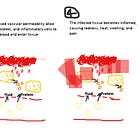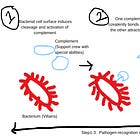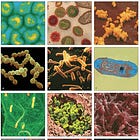The Power of Recognition: What Sets Adaptive Immunity Apart
-Why Adaptive Immunity is so Precise
Welcome back, Readers!!!!!!
In last article, we learnt about our castle’s(Your body) second defence system, i.e. Adaptive Immune system. Adaptive Immunity is also called as Specific Immunity or Acquired Immunity, You can read more about adaptive immunity here:-
We’ve already seen how your castle’s two defence teams Innate Immunity and Adaptive Immunity work together.
But today, we reveal the ultimate difference between them: how they recognize their enemies!
(Today’s article will be short)
Innate vs. Adaptive: The Power of Recognition
Think of it this way as both superhero teams use similar moves to defeat villains. The difference isn’t how they fight and it’s what they fight and how they spot the threat.
(Image via OpenAI)
Innate Immunity: The Generalists
Your innate immunity is like a squad of vigilant security guards.
They rely on a general "wanted poster" of bad guy traits. Their receptors spot features that whole groups of villains share like the armor all bacteria wear.
But… they can’t tell the difference between one type of bacteria and another. They’re fast, reliable, but not super-specific.
Adaptive Immunity: The Specialists Or Detectives
Now enter the adaptive immunity team elite detectives called lymphocytes.
Each detective has one type of receptor. But here’s the twist: your body can generate billions of different receptor versions, each tuned to a unique villain. It’s like having a massive detective squad, and each one carries a key that fits the lock of only a single enemy.
The Secret Behind Super-Specificity
So how do your lymphocytes create billions of unique receptors from the same basic blueprint? It’s an incredible process. The genes that create these receptors are not like regular genes. Instead, they are like a giant set of building blocks that get cut, spliced, and rearranged during the development of each lymphocyte. This random mixing and matching ensures that every single lymphocyte is programmed to create just one unique version of the receptor. This is also how your body can create a defense for a new pathogen that it has never encountered before.
Because of this, among the vast population of lymphocytes in your body, there are billions of different receptor versions represented. This means that no matter what new pathogen you encounter, your body almost certainly has a lymphocyte with a receptor ready to recognize it. This allows the adaptive immune system to make its response incredibly specific, targeting only the cells that are a threat.
If above explanation not understandable then Just remember, they have mind blowing genetic trick like Their receptor genes are like a giant LEGO set. During lymphocyte development, these pieces get shuffled, cut, and spliced in endless combinations creating billions of unique receptors.
This ensures your body can recognize any pathogen, even ones it has never seen before.
Among your trillions of lymphocytes, there’s almost always one detective carrying the perfect key for any intruder that dares to show up.
And that’s the true power of adaptive immunity: precision recognition. While innate immunity casts a wide net, adaptive immunity zooms in like a sniper, finding, locking, and eliminating the exact threat.
References:
Parham, P., & Parham, P. (2014). The Immune System (4th ed.). W.W. Norton & Company. https://doi.org/10.1201/9781317511571
Kuby Immunology Judy A. Owen, Jenni Punt, Sharon Stranford
Basic Immunology (Fifth edition), by Abul K. Abbas, Andrew H. Lichtman and Shiv Pillai.
You can read previous Immunology quests here:- Thanks!!!!








Such a fascinating thing! One of the most interesting stuff I've ever studied, thanks for sharing it : )
I have read about body antibodies killing the antigen in 12th. But I was always confused about how can they be absolutely specific for that particular antigen. I got my answer today. This was a really very nice read. Thank you for explaining it in such an interesting way.
Really helpful.